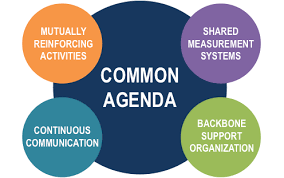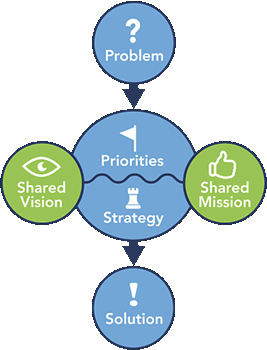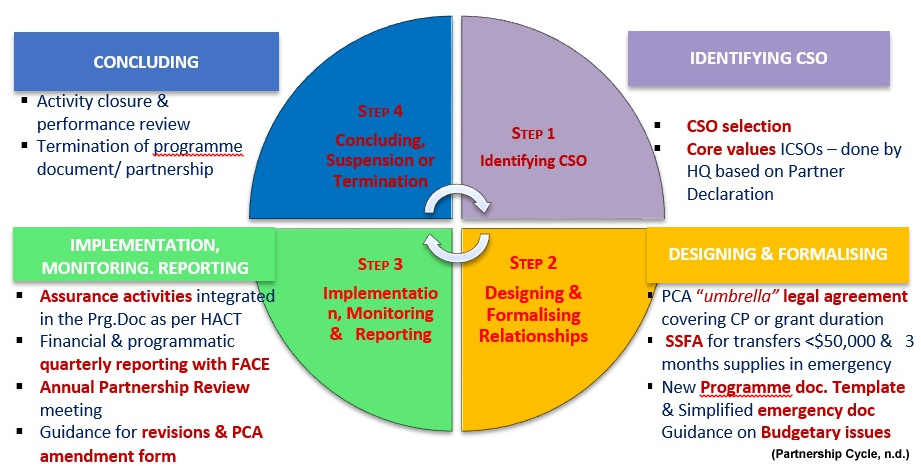Local and National Partnerships: A cooperative arrangement in the local context involving members stakeholders of the public, private, community and voluntary sector organizations, which allocate funding and address various problems affecting local infrastructures, systems, services and communities, as well as strategies and initiatives to intervene and solve them.
Global Partnership: two or more firms from different countries work as a team. They pool their resources or skills to provide better products or services. ... Firms engage in global strategic partnerships because they believe the partnership will lead to synergy, which means increased economic benefits.
Collective Impact Partnership: All participants have a shared vision for change including a common understanding of the problem and a joint approach to solving it through agreed upon actions.
Corporate Partnerships (Formal Partnership) - A mutually beneficial relationship formed between a nonprofit or charitable organization and for-profit businesses whose purpose is to pursue a common goal based on the shared values of participating organizations (Corporate, n.d.). A corporate partnership usually consists of employers looking to hire people, an agreement where terms are negotiated, and agreement is written up and expectations are very clear.
Trade Agreements (non-formal) - Any contractual arrangement between states concerning their trade relationships. Trade agreements may be bilateral or multilateral; usually between two states or more than two states (Trade, n.d.). Almost always an informal partnership, no contract is needed.
Memorandum of Understanding, MOU (Formal) - is a formal agreement between two or more parties. Companies and organizations can use MOUs to establish official partnerships. MOUs are not legally binding but they carry a degree of seriousness and mutual respect, stronger than a gentlemen's agreement (Memorandum, n.d.). Outlines what both parties responsibilities are to each other, an MOU also gives legal power to do work on behalf of the partnership.
Student Placement Agreement (Formal): Establishes a relationship between the University and the Facility to enable an educational experience for students at the Facility’s site that may qualify for academic credit at the University, as determined by the University (StudentPlacementAgreement, n.d.). This type of partnership formalizes the partnership with a student, also covers any legal or liability issues that may occur when the child is in the community.
|


|
How to Form a Partnership |
There are two main steps in forming a partnership; defining the need for a partnership and actually starting the process.
Step 1. Defining the need for a partnership and Identifying Self-Interest:
In defining the need for a partnership, you should think not only about what the partnership can accomplish as a whole, but about the potential concrete benefits to your organization in particular
- .Short-term interest(12 months): What does your organization need TO stay engaged in the partnership?
- Long-term interest (18-36 months): What does your organization need to stay engaged in the partnership?
Possible needs: additional organizational members or volunteers; enhanced products or services; greater community credibility or support; and improved access to businesses, agencies, or foundations.
|
TIPS FOR DEFINING THE NEED FOR A PARTNERSHIP
- Consult with all relevant stakeholders to establish a clear need for the partnership
- Check for any other partnerships doing similar work
- Ensure commitment is there
Step 2. Actually starting the process: There are 4 stages of developing a partnership:
- Forming: Bringing people together
- Storming: Brainstorming
- Norming: reaching shared agreements
- Performing.
|
|
IDENTIFYING POSSIBLE PARTNERS |
Checklist for starting a partnership
- Identify potential members.
- Identify responsibilities, arrangements, and objectives of leadership.
- Identify the shared vision and goals:
Determine plans and priorities.
- Determine the function and nature of the partnership.
- Identify benefits for target groups.
CHECKLIST FOR IDENTIFYING POTENTIAL PARTNERSHIPS:
- Is there a need for a partnership?
- What organizational and collective benefits will be gained from setting up this partnership arrangement?
- is someone else already doing something similar?
- Is there a commitment from partner organizations to support the partnership?
- What strategies/local priorities will this partnership support?
TIPS FOR STARTING THE PROCESS: Ensure members of the partnership participate from the earliest opportunity to help determine the entity’s structure, |
|
Top 6 Benefits for Businesses in Strategic Partnerships
(Top 6, n.d.) |
1. Acquire New Customers: Increased market share and market access are the leading reasons businesses seek new partnerships, with 68 percent of executives listing acquiring new customers as a main benefit of effective alliances. Businesses can participate in new supplier-vendor relationships, form ongoing deals with import/export firms and more in order to increase market share and access.
2. Increase Revenue: 66 percent of senior executives view increased revenue as a primary advantage of successful partnerships. When their strategic objectives align and their resources complement each other, business partners can provide each other new market access and, in turn, new revenue streams.
3. Expand Geographic Reach: Expanding distribution is among the top three benefits sought by businesses entering into partnerships, with 32 percent of executives naming expanding geographic reach as a primary goal of their partnerships. Tightly linked to accessing new customers and revenue channels, geographic expansion is often a first step toward new growth.
4. Extend Product Lines: 27 percent of executives list product diversification as a primary goal of strategic partnerships. Businesses often collaborate to gain access to the materials, knowledge or market they need to extend their product lines.
5. Access New Technologies and IP: Partnerships are often an ideal way to access new technologies without expending resources. Just over a quarter, or 26 percent, of business leaders list gaining access to new technology or intellectual property as a benefit of strategic partnerships.
6. Add Sharing Resources: Along the same lines of accessing new technologies and IP, businesses also enter strategic partnerships in order to pool resources. 23 percent of executives cite adding sharing resources as a primary objective of partnerships, effectively advancing them on their path to innovation. |
The Partnership Cycle |
|
|
Definition:
(Collaborating, n.d.). |
Principals of a Common Agenda (Collaborating, n.d.) |
| 1. Principles: Agreed upon values that guide the group in laying out the rest of the common agenda, making decisions, and how the group is going to work together overall. |
The 5 Elements of a Collective Impact
(Collaborating, n.d.) 
|
| 2. Common Problem Definition: A common understanding of the problem the group is trying to solve. Often this involves establishing boundaries for what issues, players, and systems the group will in engage with, and which are outside its scope. The problem definition is built on a shared understanding of the root causes of the issue at hand. |
| 3. Goal: A measurable, population level goal that demonstrates how you will define success. |
| 4. Framework for Change: A structure for how the group will split up the work (into working groups, backbone roles, policy groups, etc.) and prioritize limited resources. |
| 5. Plan for Learning: A plan for how you intend to track your progress and learn from your efforts as an initiative. |
4 Ways a Common Agenda Can Enhance a Partnership |
1. SHARED VISION: All the partners in a partnership that share a common agenda all share the same vision; they are alike in desired end result, where they want to take the organization and how they want to impact a targeted population, but approach it from different priorities and specializations. The partners may not share strategies, but they share a common goal. |
 (Stanchowiak, 2018)
(Stanchowiak, 2018) |
| 2. IT CREATES SUSTAINABLE RELATIONSHIPS: Working together as residents and stakeholders while coordinating efforts will help achieve a shared vision for change and accomplish the organizations goals (Why, n.d.). By working together and sharing vision and goals relationships are formed based on what strengths and weakness are. |
| 3. SHARED RESPONSABILITY: Each partner may have a separate strategy for how to get to the desired result, but they all share in the responsibility for not getting there. As seen in the graph to the right, partners don't necessarily need to share priorities and strategy to approach a problem, as long as they share vision, mission and responsibility and the "rules of engagement" are set. |
4. RESPECTFUL COMMUNICATION: Everyone has a right to express an opinion, and every view is valued for the purpose of moving WINS forward, independently and collaboratively (Why, n.d.) As long as their is respectful communication the partners can have different opinions, strategies and approaches and still keep the shared goal in mind.
|







